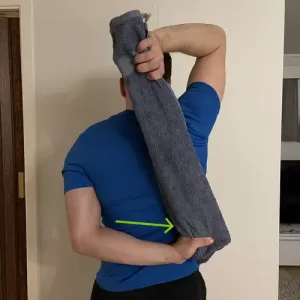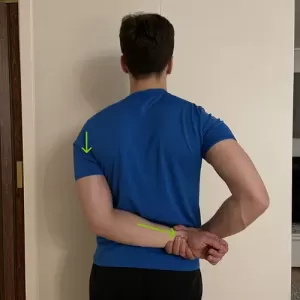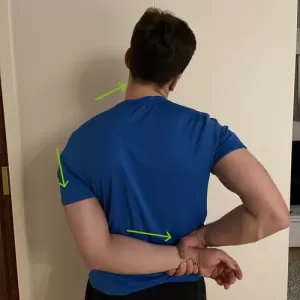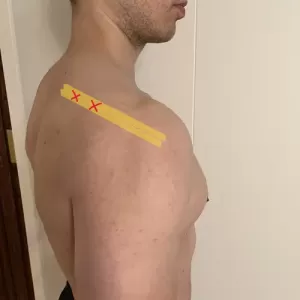Effective Supraspinatus Stretch: How to Relieve Shoulder Pain and Improve Mobility
Introduction
The supraspinatus muscle is a small, but important muscle located in the shoulder. It is one of the four muscles that make up the rotator cuff and its primary function is to assist with arm abduction and stabilization of the shoulder joint.
A healthy supraspinatus muscle is a must-have if you want to use the full potential of your shoulder strength (overhead strength) and stability during sports like baseball or basketball.
Supraspinatus Stretch: Guide for Flexibility And Muscle Tension Relief
Here are some stretches that can help you loosen your supraspinatus muscle:
Dynamic Supraspinatus Stretch with Towel
From a standing position, grab a towel with your both hands and place one hand on your back.
Gently push to the opposite side with your hand on your back.
Stop when you feel the supraspinatus stretch and repeat ten times.
Standing Supraspinatus Stretch
From a standing position, grab one hand (just below the wrist) with your other hand and gently pull towards the opposite side.
Make sure your shoulder is relaxed and in slight traction.
Hold this stretch for 30s.
Supraspinatus Muscle Stretch with Neck Side Flexion
From standing position:
- Push with your shoulder down.
- Place your hand on your back
- Pull your hand with your other hand
- Flex your neck to the opposite side you’re stretching.
Hold for 30s.
Tips When Stretching Supraspinatus
When performing these stretches, maintain proper posture to avoid putting unnecessary strain on the supraspinatus muscle.
Keep your shoulders back, your chest out, and your core engaged. Avoid overstretching or pushing too hard, and listen to your body.
Using stretching guides, stretching tools and supraspinatus muscle and tendon stretch you can improve the flexibility and strength of the supraspinatus muscle.
Consult with a physical therapist or personal trainer for personalized stretching and exercise plans and to address any specific needs or concerns.
Here you can see a simple, yet effective guide including stretches for supraspinatus muscle and few exercises for shoulder mobility and stability.
Causes of Tight Supraspinatus
There are several common causes of tightness in the supraspinatus muscle. These include:
- Overuse or repetitive motions: Activities that involve repetitive overhead movements, such as throwing a ball, playing tennis or painting a ceiling, can cause the supraspinatus muscle to become overworked and fatigued. This can lead to microtrauma and inflammation, resulting in muscle tightness.
- Poor posture: Poor posture, such as slouching or hunching forward, can put extra strain on the supraspinatus muscle. When the muscle is in a shortened position for prolonged periods, it can lead to muscle tightness and weakness.
- Inactivity or lack of regular exercise: When the supraspinatus muscle is not used regularly, it can become tight and weak. This can happen if you have a sedentary lifestyle, or if you are recovering from an injury or surgery.
- Age: As we age, our muscles naturally lose flexibility and strength, and the supraspinatus muscle is no exception. This can lead to muscle tightness and weakness, making it more susceptible to injury.
- Trauma or injury: Trauma or injury to the shoulder, such as a rotator cuff tear, can cause inflammation and tightness in the supraspinatus muscle. This can happen from a fall, impact, or direct injury.
Tightness in the supraspinatus muscle can lead to a number of issues. It can cause pain and discomfort in the shoulder and upper arm, limited range of motion in the shoulder, weakness in the arm and shoulder, increased risk of injury to the rotator cuff and difficulty with daily activities, such as reaching overhead or combing your hair.
If not treated, it can lead to chronic pain and even rotator cuff tears.
Self-Massage and Release Techniques
In addition to stretching and exercising, self-massage and release techniques can also be effective in relieving tightness and pain in the supraspinatus muscle.
Here are some methods you can try:
Release of Supraspinatus Trigger Points: Use a foam roller or a tennis ball to apply pressure to the area between your shoulder blade and spine, where the supraspinatus muscle is located. Roll back and forth or apply pressure to the area for 30 seconds to a minute, then release. Repeat as needed.
Self-Massage: Using your fingers or a massage tool, apply gentle pressure to the supraspinatus muscle, working your way from the top of the muscle near the shoulder blade down to the bottom of the muscle near the spine. Use circular or back-and-forth motions to release tension.
Yellow: self-massage area
Red: trigger points area
Diagnosis and Management of Supraspinatus Injury
Pain Location: Supraspinatus pain is typically felt on the top of the shoulder, near the shoulder blade. It can also radiate down the arm and cause weakness in the shoulder.
Testing for Injury: A physical therapist or doctor can perform a variety of tests to diagnose a supraspinatus injury, including the supraspinatus test, which involves lifting the arm out to the side with the palm facing down and resistance applied to the arm. Other special tests for the shoulder include the Neer test, the Hawkins-Kennedy test, and the Empty Can test.
Healing Time: The healing time for a supraspinatus injury can vary depending on the severity of the injury. Mild injuries may heal within a few weeks with rest and physical therapy, while more severe injuries may take several months or longer to fully heal.
Massaging rotator cuff injuries: Massaging rotator cuff injury is not recommended as the risk of aggravation or causing further damage is high. It’s best to consult with a physical therapist or doctor to determine the best course of treatment.
Exercise to avoid: It is important to avoid exercises that put excessive stress on the supraspinatus muscle, such as overhead pressing or heavy lifting. It is also important to avoid activities that involve repetitive overhead motions, such as swimming or throwing a baseball. Your physical therapist will be able to advise you on what exercises you should avoid and what exercises are safe for you to perform.
Conclusion
The supraspinatus muscle plays a crucial role in shoulder function and is often prone to tightness, weakness and injury.
Incorporating supraspinatus stretches and exercises into your regular routine can help to prevent tightness and injury, and improve overall shoulder health. I
It’s important to consult with a physical therapist or doctor if you are experiencing pain or discomfort in your shoulder to get a proper diagnosis and treatment plan. Remember to avoid exercises that put excessive stress on the supraspinatus muscle and to follow stretching guides for better results. Improving posture is also a helpful way to prevent supraspinatus injury.
Overall, regular stretching and exercise can help you keep the supraspinatus muscle healthy, strong, and flexible.









